The Sierra High Route, detailed by Steve Roper in his book of the same title, is a 195-mile route through some of the most rugged and beautiful country the Sierra Nevada have to offer. Much of the route is off-trail with plenty of class 2 and class 3 terrain and complete solitude. The Sierra High Route (SHR) parallels the John Muir Trail (JMT) for much of its duration but stays high when the JMT dips low. Having hiked the JMT last season, my goal for this summer is to complete the SHR. However, I have very little cross-country hiking experience and, wanting to gauge just what Roper means by “challenging climb” and “easy stroll” in his route description, I planned this 55-mile loop route as an SHR trial run.
The trek was a tremendous success – Amanda and I didn’t use the GPS at all! We had a great time exploring the high country when we weren’t cussing out the mosquitos, gasping for breath on a long climb, or nursing battered feet after a grueling descent. In all seriousness, this loop was more challenging than any other hike I’ve attempted, both physically and mentally, but simultaneously incredibly rewarding and breathtakingly beautiful. I would recommend the SHR to anyone with the guts and stamina to leave the beaten path behind.
This trip includes most of the first Sierra High Route section which Roper names “Cirque Country” and is labeled “Cirque (1)”; additional posts detail my journey along the rest of the high route.
Trip Planning
Specs: 54.9 mi | +/- 15,600 ft | 4 days, 4 nights
Difficulty: Class 1 with plenty of class 2 scrambling; the ascent to Frozen Lake Pass is class 3 [learn more]
Location: Sequoia-Kings Canyon National Park | Home of Eastern Mono/Monache and Northern Paiute peoples | View on Map
Route – This loop includes the first 25 miles of the SHR, followed by about 15 miles on the JMT and 15 miles on the Woods Creek Trail back to the trailhead at Road’s End. Begin at the Copper Creek trailhead and follow the SHR until it joins the JMT in Upper Basin below Mather Pass. From this junction, follow the JMT south-bound to the Woods Creek suspension bridge. At the bridge, the JMT crosses Woods Creek and travels uphill to the Rae Lakes; this loop instead continues down the Woods Creek trail, past Paradise Valley, to return to Road’s End.
Permit & Regulations – The Copper Creek trailhead (and the entire loop) lies within the borders of Sequoia-Kings Canyon National Park, so you’ll need to obtain a permit from them (email in a PDF application). The Copper Creek trailhead is far less popular than the Bubbs and Woods Creek trails that bookend the Rae Lakes Loop, so you shouldn’t have too much competition! Keep in mind that campfires are prohibited above about 10,000 feet (varies by regulating agency and park), and that, as a cross-country traveler through the remote wilderness, you must take care to leave no trace.
Resources – Navigating this off-trail route requires some extra preparation. Roper’s book is an indispensable and light-hearted resource for the SHR portion of the trek. I created an interactive map of the SHR while researching this hike that you may find useful, particularly by printing out the relevant portions of the map at a scale of your choosing. You can also download the GPX/KML waypoints from this resource to use with a navigational aid, such as the Gaia GPS app (my personal choice). There are many printed maps available for this area; I packed the Sequoia-Kings Canyon map published by National Geographic since it covers the entire area of this hike and is tear- and water-resistant.
First Steps on the Sierra High Route
4 July 2018 | 11 mi | +7000 / -1400 ft | View on Map
After waiting impatiently in line at the Road’s End permit station to receive our permit, Amanda and I lock the car, stash our deodorant and leftover road trip snacks in a nearby bear box, and begin the climb up the Copper Creek Trail. A haze obscures the distant peaks – smoke? Surely not smog? Although it’s only barely 8:30, the air is already warm and the sun is surprisingly high in the sky. The first few miles (or what feels like a few miles… I’m a terrible judge of distance while hiking) are sunny and exposed; shadeless. Although the trail follows gently-ascending switchbacks, our packs are heavy with supplies for the four-day trip and we’re soon dripping sweat.
As we climb higher, we reach larger trees that supply some cover from the sun. However, with the shade comes steeper trail, as the ranger laughingly warned us this morning at the permit station. Still, Amanda and I bear the exertion more easily in the cool shadows. We push through sunny stretches of trail between shade oases and climb higher still. The views begin to improve after an hour or two and several thousand feet of elevation gain. It’s too bad the air is so hazy.

On our way up the endless switchbacks, we pass several creeks lined with lush grass and plentiful wildflowers. I toss my hat in to soak up some of the cold water, Amanda submerges her entire shirt, and we both enjoy the refreshing chill of the evaporating water as we continue to climb.
By the time 1 PM rolls around, we’re both tired and hungry, so we drop our packs in the middle of a shaded switchback and dig out lunch: dried mangos, peanut butter, and tortillas. We devour the food and then munch on some Oreos to top off the extremely health-conscious meal. You have to adjust your thinking when packing food for a backpacking trip; rather than trying to minimize your caloric intake, you need to maximize it. Peanut butter and cookies do the trick.
After lunch, we continue up even more switchbacks, thankfully mostly in the shade of towering pines. Amanda is beginning to wonder why in the world she agreed to join me on this hellish, infinite climb, and I can’t blame her. We began this morning at about 5,200 feet above sea level and have climbed around 5,000 feet in the past four and a half hours. Patches of blue sky through the trees continue to give us false hopes that we’ve reached the top of the climb.
We finally reach a saddle where the trail levels out and take a break on a large, flat slab of granite. This is the end of our on-trail journey for the next couple days; from here on out, we’re bushwhacking through the backcountry! I pull Roper’s route description out of my backpack and read the instructions aloud, “This welcome resting spot marks the beginning of a truly adventurous portion of the High Route, for here the hiker leaves the trail to begin wandering cross-country through the subalpine landscape.” That’s us! We’re about to begin adventuring!
After catching our breath and collecting our wits, Amanda and I leave the trail and head north-northeast through a pleasant pine forest. This hiking is infinitely more stimulating than the switchbacks; we’re constantly zig-zagging between trees, climbing up and down and over rocks, and identifying new landmarks in line with the compass bearing. The Grouse Lake outlet stream, surrounded by meadows, lies below and to our right as we trek through the woods. Upon reaching higher ground away from the trees, we look back and can’t help but laugh at the breathtaking views: granite, pines, alpine meadows, and the imposing Kaweah Peaks in the distance. This cross-country hiking rocks!

We soon spot the gleaming waters of Grouse Lake and make a beeline for the shore. We wade around in the chilly water for a few minutes and try to avoid the mosquitoes that seem to plague every beautiful mountain lake in this mountain range (at least early in the season). Unfortunately, we can’t afford to stay long and move on after a brief rest; we have plenty of daylight and there are more miles left to cover!
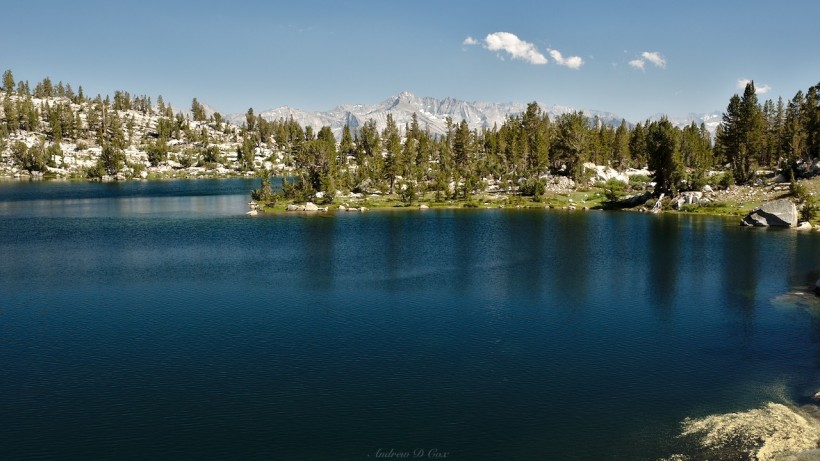
The next landmark on the High Route is Grouse Lake Pass, a low saddle between two peaks above the lake. From the lakeshore, we wind our way up granite slabs and grassy ramps, thoroughly enjoying the experience. I prefer to wind across the landscape, making my own switchbacks as I go. Amanda, on the other hand, prefers a more direct route and trudges deliberately up the slope toward the saddle.
“Bushwhacking” is perhaps too aggressive a term for this kind of cross-country travel, for there really aren’t any bushes to whack, just lots of grass, wildflowers, and scruffy pine trees. Other than the steep incline, it’s really not any more difficult to hike in this subalpine paradise than on a well-traveled trail. That being said, any kind of uphill climb at this altitude (11,000 ft) is difficult on the first day. We’re not yet acclimated and our lungs struggle to extract enough oxygen from the thin air to fuel our muscles. I pause every few minutes to catch my breath and slow my racing heart, giving me a chance to snap a few photos and admire the scenery.

We soon reach Grouse Lake Pass and, stunned by the awesome views, pause our trek for a few minutes. The Kaweah Peaks dominate the view to the south, with Grouse Lake gleaming like a sapphire in a ring of white granite in the foreground. Our view to the west includes half a dozen shimmering lakes, all inviting. Roper anticipates their attraction and explicitly cautions against descending to their banks. Our path lies to the north, toward Goat Crest Saddle. We reluctantly follow his advice and, after munching on trail mix, continue our journey.
Any regrets we have of walking away from the lakes below are short-lived as we soon reach a small snowbank. Amanda takes advantage of this rare July opportunity to make a snow angel! Before leaving, she stuffs some snow in her pockets to ease her aching hips and I fill my hat to cool my head.
For the next few miles, a passing hiker (if there were any) might assume I have a sweating problem as the snow melts and runs down my head. Quite the contrary: For the first time all day, we hike downhill, speeding across soft meadows and along the shores of little tarns with relatively little effort. What a beautiful landscape!
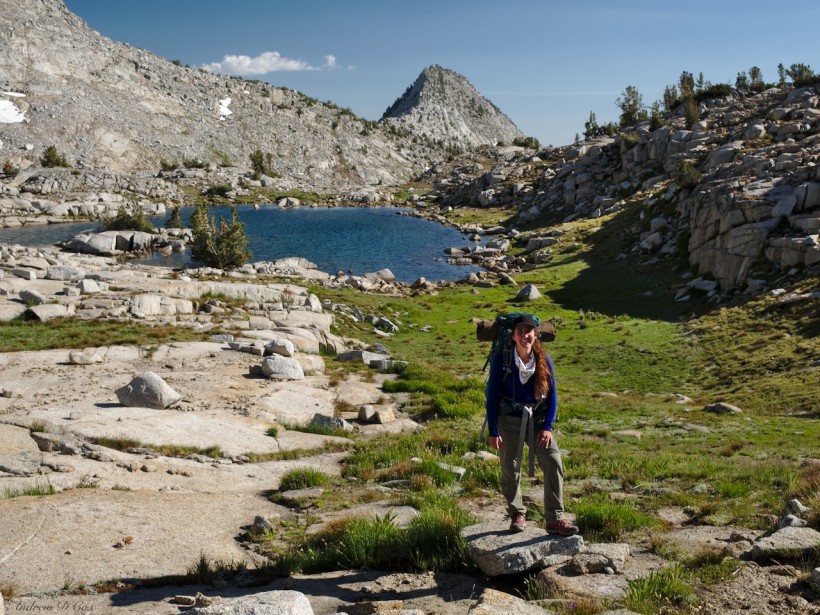
Of course, we’re not actually done climbing for the day. With the sun beginning to drop toward the western horizon, we have time for one final pass: Goat Crest Saddle. The approach isn’t terribly steep, but the thin air continues to make every exertion twice as difficult as usual. Amanda and I pause on the way up to appreciate the plentiful shooting stars waving in the breeze.
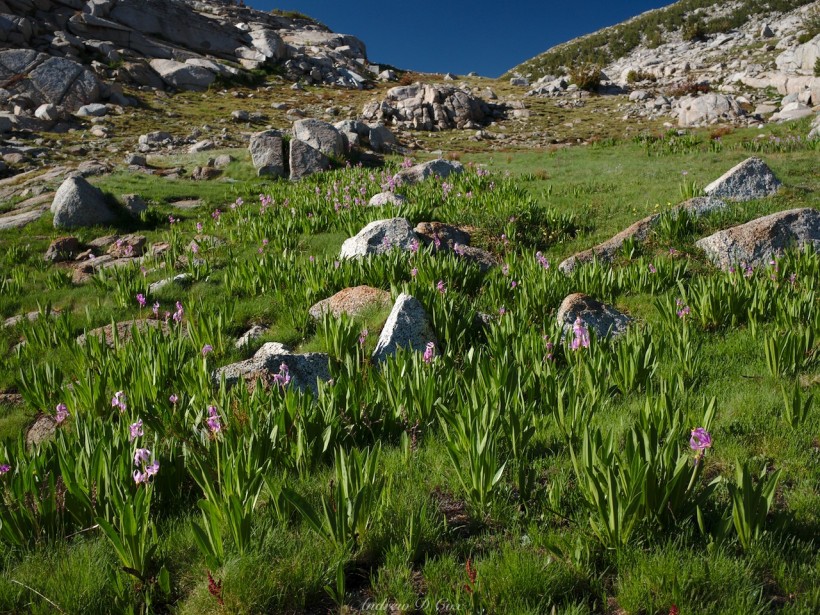
During the final hundred yards of the ascent to Goat Crest Saddle, we crunch through sandy soil and notice footprints: other High Route trekkers have been here, a good sign that we haven’t completely lost our way. The pass itself lies in shadow and appears to remain that way most of the time, judging by the amount of snow and ice there. We pick our way around the edge, carefully avoiding the electric-blue tarn that is sure to be absolutely freezing. Beyond the shaded foreground, the Palisades shine in the evening light to the north. We’re heading in that general direction for the next several days!
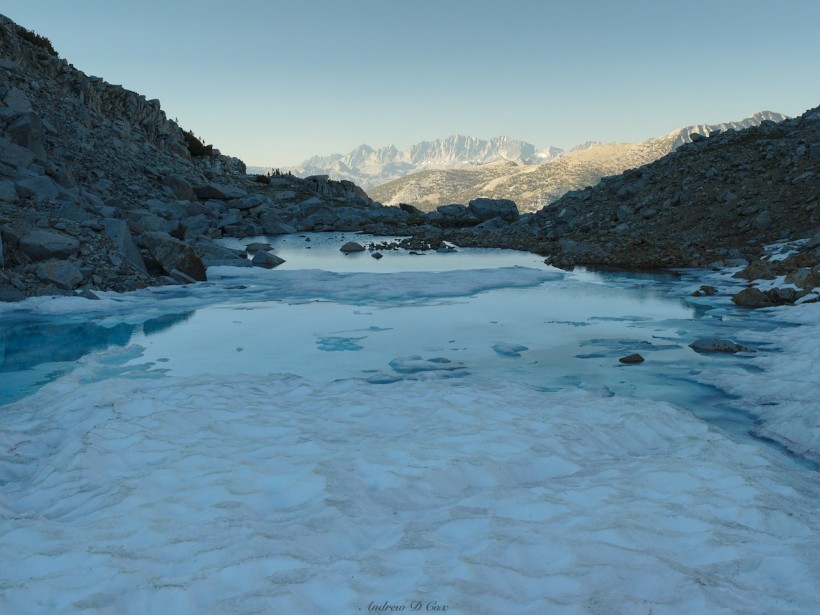
Past the small snowfield and icy tarn, Amanda and I reach the edge of a steep slope. Granite Lake shines in the warm light below; we’ll camp there tonight. However, we have to get down to the water first. We have two options: we can clamber and hop down large talus boulders for several hundred yards or navigate our way down a relatively steep snowfield. The boulders don’t look like much fun, so we head for the snow. It’s Amanda’s first time glissading and her excitement is contagious; we’re both laughing like children when we slide to a halt at the bottom of the snow.
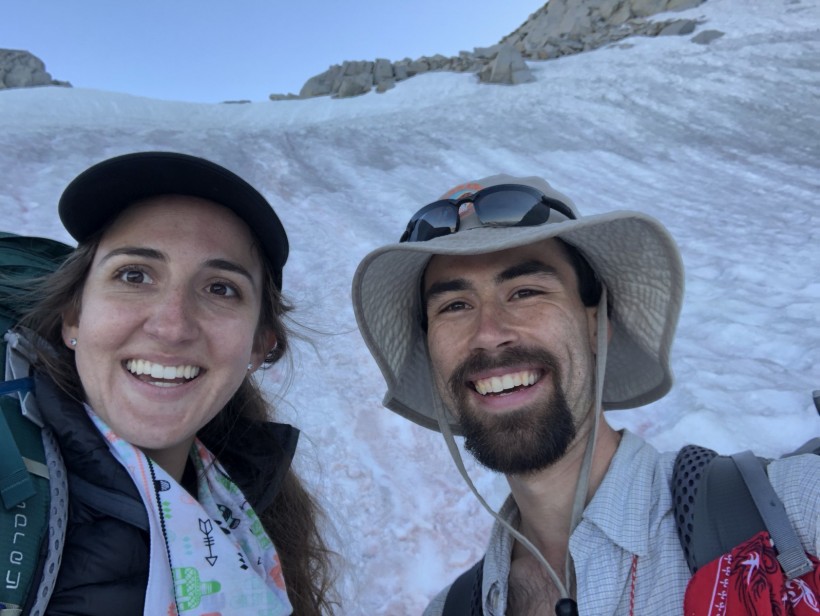
Unfortunately, the snow doesn’t reach all the way to the lake and we have some boulder hopping to do anyway. The talus soon gives way to grass interspersed with rocks and we make quick work of the remaining descent. Daylight is fading fast as we reach the lakeshore and identify a small, tent-sized patch of sand between granite slabs. We set up camp and then sit back and relax while heating water for dinner. The mosquitoes soon learn of our arrival and bring their friends to suck our blood. Without the mosquitoes, backpacking in the Sierras would be absolute bliss. With the mosquitoes… well, it’s still pretty incredible.
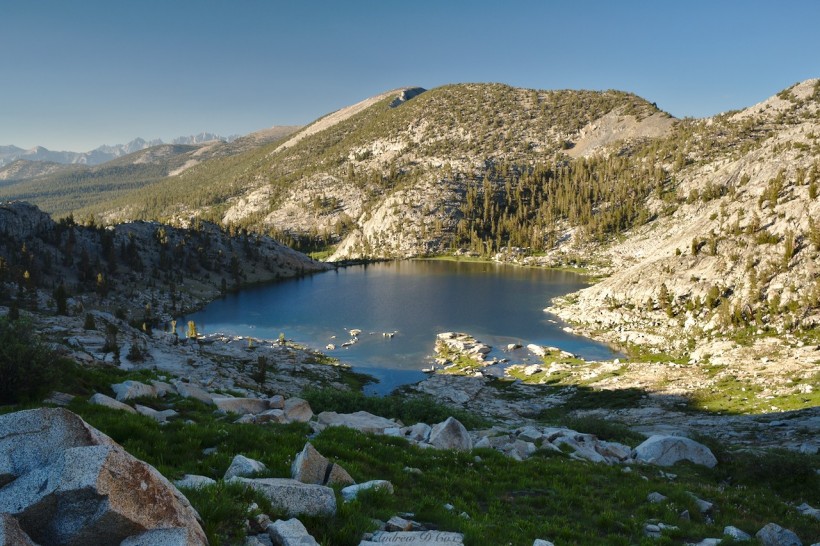
After cooking and eating dinner, Amanda and I stash our scented items in the bear canister and retreat to the bug-free safety of the tent. After the long climb on Copper Creek Trail and the exciting, off-trail afternoon, we’re both exhausted and soon fall asleep.
White Pass and Red Pass
5 July 2018 | 10.3 mi | +3300 / -3700 ft | View on Map
The next morning, Amanda and I rise early to get a head start on the day. I heat water for oatmeal and coffee while Amanda packs up the tent, and then we sit down and enjoy breakfast. It’s a beautiful morning with characteristic Sierra weather: blue skies, no clouds, and bright sunshine. The mosquitoes seem to have forgotten about us for the moment too!
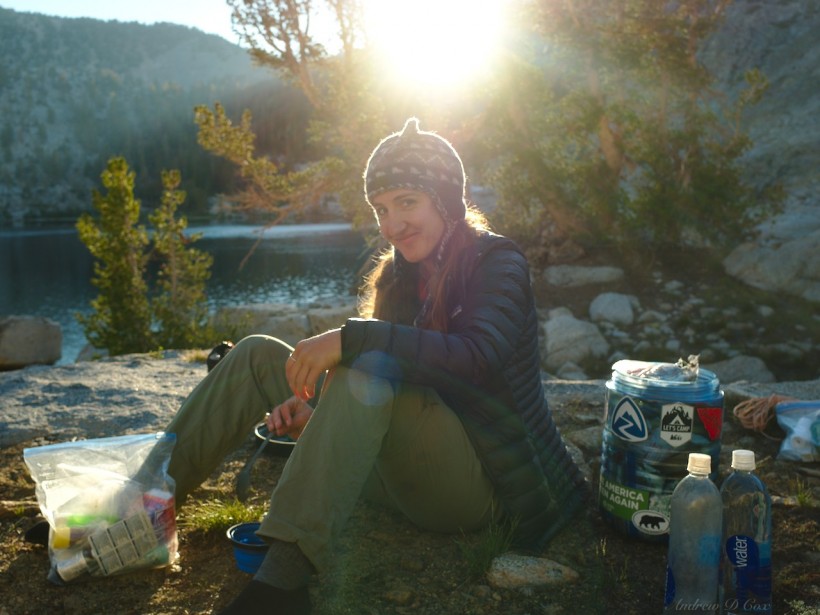
After breakfast and a thorough look around camp to make sure we aren’t forgetting anything, we shoulder our packs and begin hiking. The High Route proceeds past Upper Glacier Lake, down to a lower Glacier Lake, and then descends a series of forested granite ramps to Glacier Valley. We make quick work of the descent to the lower lake but pause at the edge of a steep dropoff above Glacier Valley. Our path ahead is completely forested, but looks relatively flat (once we get down to the valley floor), a welcome respite from the steep ups and downs we hiked yesterday.
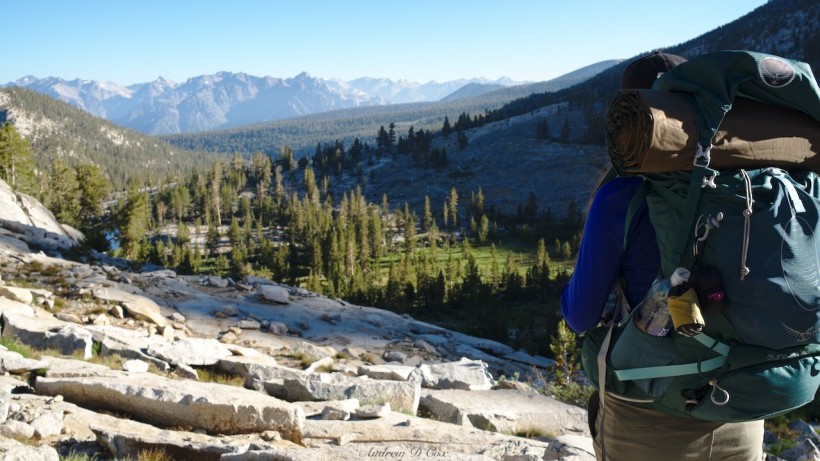
After admiring the views, checking the map, and rereading Roper’s route description, we begin our descent into the valley. Navigating the granite ramps isn’t terribly difficult, though a few are treacherously smooth or covered in pine needles that slip underfoot.

Upon reaching the valley floor, Amanda and I pick up our pace and rejoice in the flat, easy terrain. We stick to the edge of the meadow, beneath the trees, to avoid squishing through the fragile turf and also to avoid the mosquitoes that thrive in the cool, damp grass. Even in the trees, dozens of mosquitoes discover our presence and follow us for miles; head nets and long sleeves are a must to avoid being eaten alive.
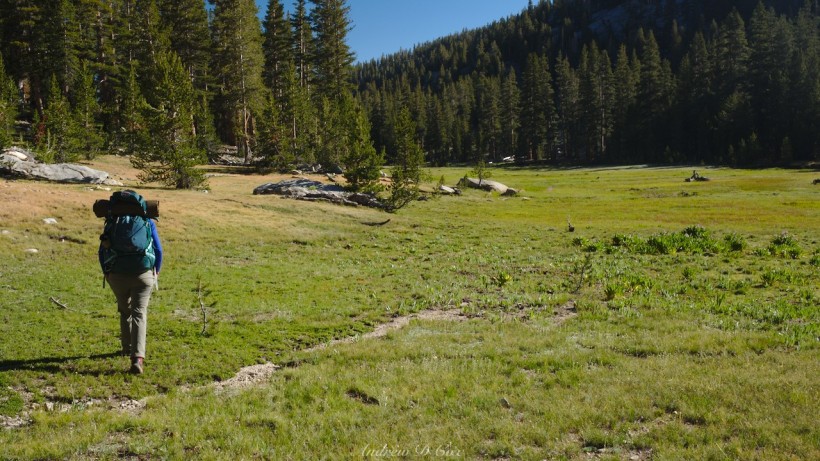
The miles slip by as we navigate the quiet meadows. We soon reach the State Lakes Trail and follow it, ascending several hundred feet to a beautiful lake and then a second lake. From here, we follow a faint trail through the woods, relying on the compass as much as the trail to find our way. Upon reaching a small sign at a trail junction, we switch trails and proceed on to the Horseshoe Lakes. The route is generally level, and we’re gifted several fantastic views of the Goat Crest, including the saddle we traversed and the snowfield we glissaded down last night. We’ve come a long way in just a few hours!
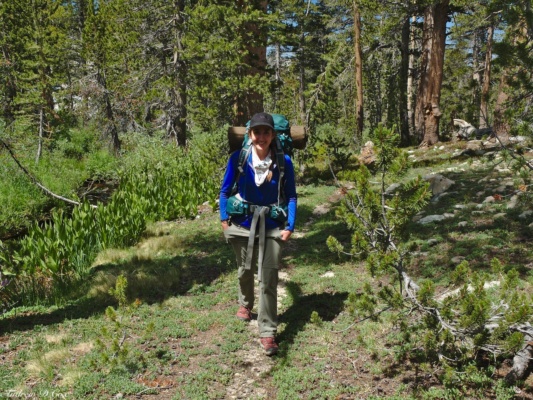
By the time we reach the first of the Horseshoe Lakes, we’re ready for a snack and a break. We soak our feet while wearing full mosquito gear, awkwardly trying to eat around the head nets. Amanda’s shoes have not been kind to her feet and she’s developed several blisters and sores. She treats them with supplies from the first aid kit and then we continue onward toward another lake, off-trail once more, following a compass heading and Steve Roper’s cheerful advice.
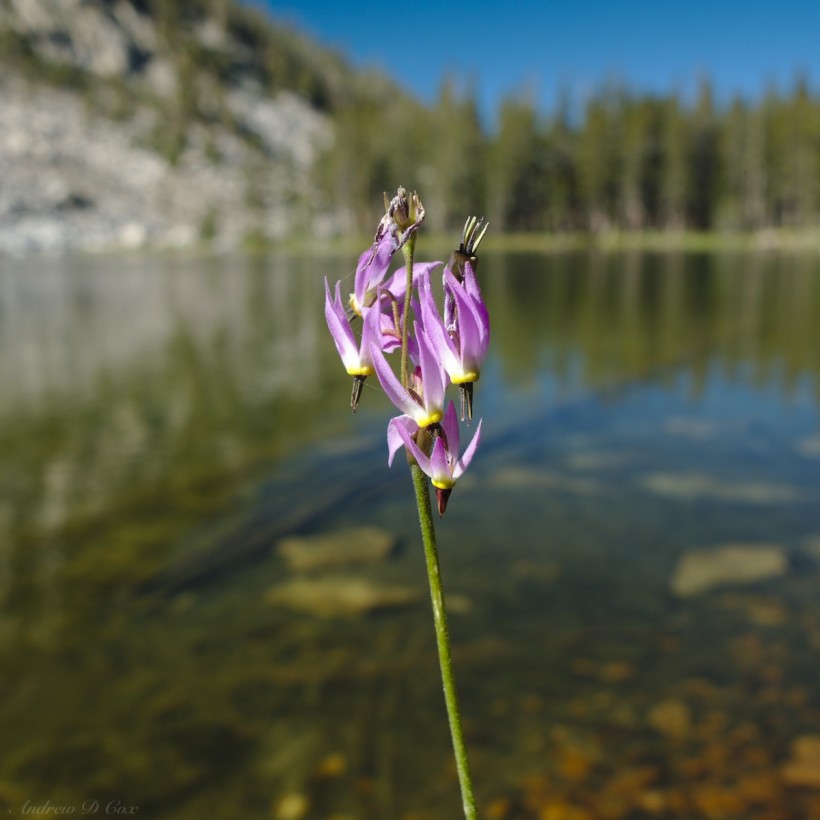
After trekking between two more Horseshoe Lakes, we begin to climb in earnest. The hot sun quickly saps our energy as we struggle up the steep, loose soil on a forested hillside. We lose sight of each other every so often while battling up the hill, but are never out of earshot; a quick cry of “Marco”, “Polo” is sufficient to locate each other.
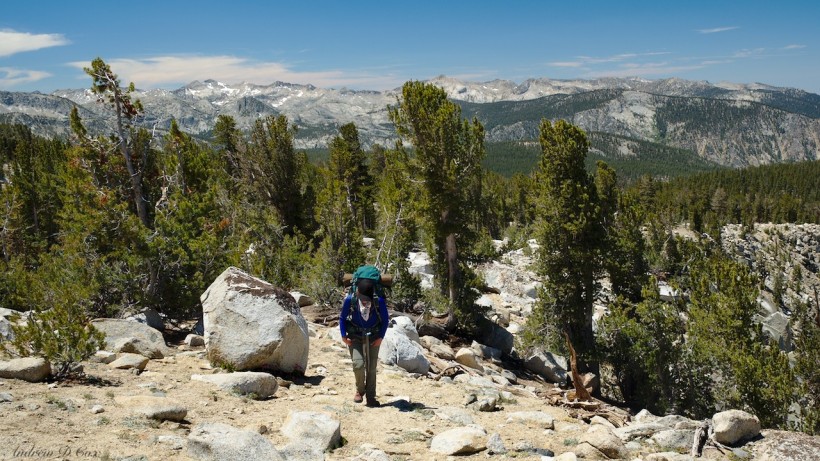
The arduous climb delivers us to the brink of Windy Canyon, i.e., Windy Ridge. Very much in need of a rest, Amanda and I find a shady spot and sit down for a few minutes, sip water, and catch our breaths. The sharp drop off immediately in front of us offers great views of the Black Divide and Devil’s Crags.

After resting for a few minutes, we continue the uphill climb, though on a shallower gradient, along Windy Canyon, remaining close to the cliff’s edge as Roper advises. We pass a lovely tarn and wander through a sandy landscape full of short grass and scrubby bushes. I miss one of the landmarks along the way, but we easily find our way to Gray Pass in the high, open country.
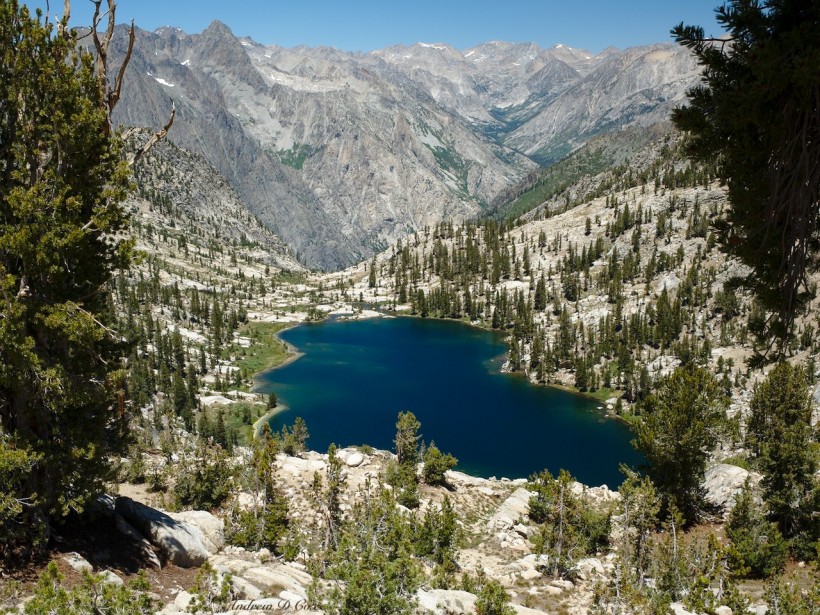
Looking east from Gray Pass, we’re treated to an incredible vista of granite peaks and, far below, grassy meadows, small lakes, and gurgling streams. Our goal is to reach White Pass, a few miles distant, but to reach the pass we must first descend all the way to those meadows and lakes. Roper directs High Route travelers to follow a “long, grassy chute” to the valley floor, so we find a feature that resembles his description and start descending. Whether or not it is the “right” grassy chute, I don’t know, but it’s likely unimportant. The downhill climb requires some careful footing and some trial-and-error route finding through thick willows and rock-strewn stream beds. Amanda descends much more quickly than I, bounding between rocks on the way down.
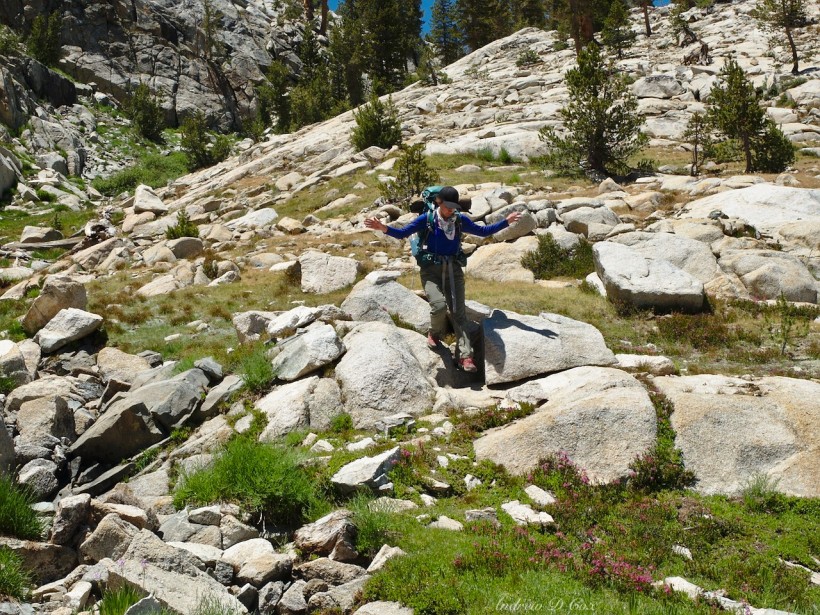
Down on the valley floor, we break for lunch – peanut butter, tortillas, and fruit again, a delicious classic! It’s not immediately clear which direction we need to travel to reach White Pass; I wasn’t all that sure which saddle it is from the top either. Given a rough estimate of our position, we need to move due east, or straight up a wall of granite. It looks passable so, after finishing lunch, we begin the climb. It’s not exactly easy, but walking up the steep stone doesn’t require any technical skills either. I pull out the map and compass several times along the way, hoping to refine our position and identify White Pass, but that information continues to elude me.
It’s not until we reach a series of grassy benches with excellent views of the valley we just left that I completely confirm our location. We’ve definitely taken a more direct route than Roper intended, but we’re on the right track! Amanda and I refill our bottles from an ice-cold creek fed by melting snow in the peaks above; the water is so clear and clean that I don’t even bother filtering.
The final few hundred yards to White Pass consist of sand and granite. The steep slope, loose soil, and thin air conspire against us, and it’s a real struggle to continue climbing. But we can’t stop yet – we have, at a minimum, several more miles to hike before we’ll reach a suitable campsite. Onward it is.
By the time we reach the top, Amanda and I are both exhausted. Breathing heavily, we take in the view and start laughing. Laughing at the ridiculousness of the fact that we’re miles from the nearest trail, laughing at the terrain we have to cross next, a difficult slope of loose talus, laughing at the mind-numbing grandeur of the peaks that surround us; fear, awe, despair, excitement, exhaustion, pride… all kinds of emotions wrapped up in laughter. It’s far too soon to continue hiking, so we sit for a while and admire the views while building the resolve necessary to navigate the next section of the Sierra High Route.
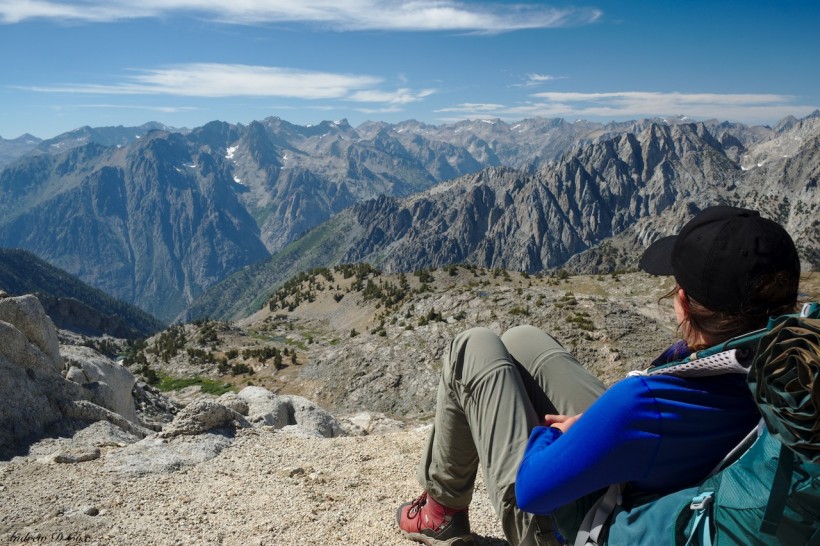
From White Pass, we follow Roper’s advice closely: ascend up class II blocks, then contour across loose talus, and finally ascend to Red Pass, a prominent saddle just across the way. Regardless of the proximity, reaching Red Pass is not easy, particularly once we start across the talus. Many of the stones shift and slide underfoot, so the traverse requires care to avoid a turned (or sprained) ankle.

After carefully navigating to Red Pass, we gaze into yet another deep valley. There’s no avoiding this descent; we have to drop well over a thousand feet to Marion Lake. Our original plan for the day was to hike up and over Frozen Lake Pass, but that isn’t going to happen. It turns out that cross-country travel is more rigorous than either of us anticipated.
Although the descent from Red Pass is long, a use trail left by previous High Route travelers makes the walk easier and guides us toward the dark blue waters of Marion Lake far below. Our laughter has faded and been replaced by stoic silence. That is, until we reach the final obstacle separating us from Marion Lake: a short, but incredibly steep chute that drops straight to the water’s edge. From the top, the chute appears impassible, but we follow previous adventurers’ footsteps, taking care to avoid sliding on the loose gravel.
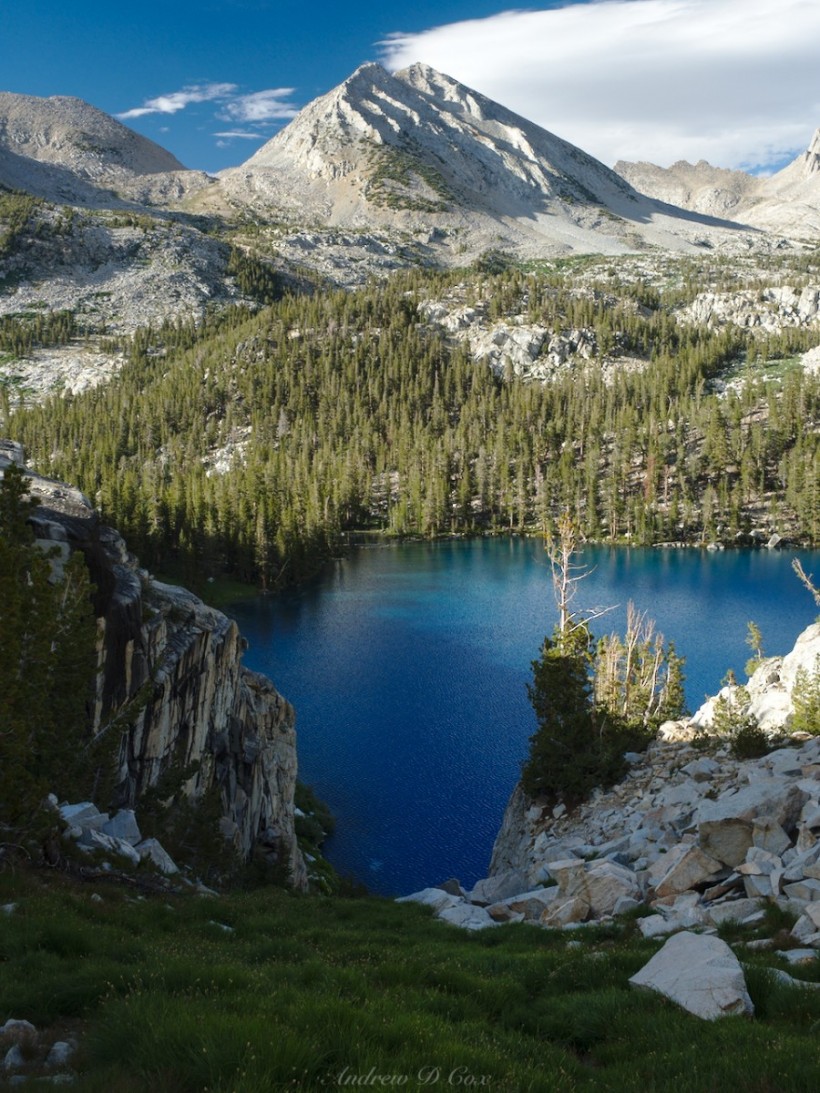
As soon as we reach the water, swarms of mosquitoes appear to greet us. We battle through willows for a short distance and then trudge into the trees near the outlet creek to locate a campsite. Amanda accrues a dozen bites in a few short minutes and retreats to the tent as soon as possible. The mosquitoes appear to be less interested in my blood than hers, so I set about making dinner (fully decked out in a head net and long sleeves of course; the airborne vampires still want to eat me) while Amanda unpacks the sleeping bags and pads.
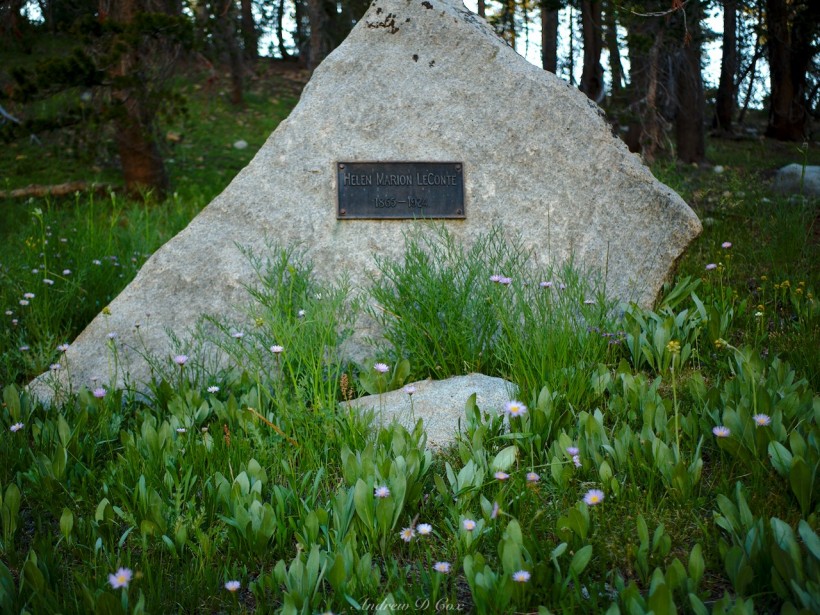
When the food (CousCous, tuna, and cheese!) has soaked up the hot water, Amanda joins me on a rocky ledge overlooking Cartridge Creek. A lively breeze discourages the mosquitoes from following us here and we eat in relative peace while watching the sun sink toward the peaks on the distant horizon. It’s a lovely evening and we’ve earned every last shred of beauty it has to offer.
With full bellies and tired bodies, we stash away the food and crawl into the tent. A few dozen mosquitoes crawl over the bug netting, trying to find their way inside. Thankfully, their search is fruitless and we’re able to fall asleep in peace.
Frozen Lake Pass and Beyond
6 July 2018 | 14.7 mi | +4400 / -3800 ft | View on Map
Morning brings cool temperatures and relatively few mosquitoes (thank the gods). Amanda and I eat breakfast, pack up camp, and begin the days’ hike. Our route today will take us over one of the High Route’s most difficult barriers (according to Roper): Frozen Lake Pass. But first, we have several miles to walk through Lake Basin. We cross the Marion Lake outlet creek and stroll through a beautiful forest. Roper references a “well-worn path” through these woods, but we never find it. Regardless, we tread easily up gently sloping terrain, passing several beautiful lakes that are smooth as glass in the still morning air.
Unfortunately, our presence in Lake Basin is soon well known to every mosquito within several miles and we are constantly surrounded by swarms of them. The devils’ persistent presence makes it difficult to navigate; I’m not entirely sure which of the many saddles to the north is the one to aim for and every time I pause to consult the map, dozens of mosquitoes land on my pants and shirt. To avoid being devoured, we cover up with head nets and keep our hands in our pockets. While I’m still unsure of which saddle is Frozen Lake Pass, finding a route in the general uphill direction is remarkably simple thanks to the abundance of grass and granite ramps, and I enjoy the walk despite the mosquitoes.
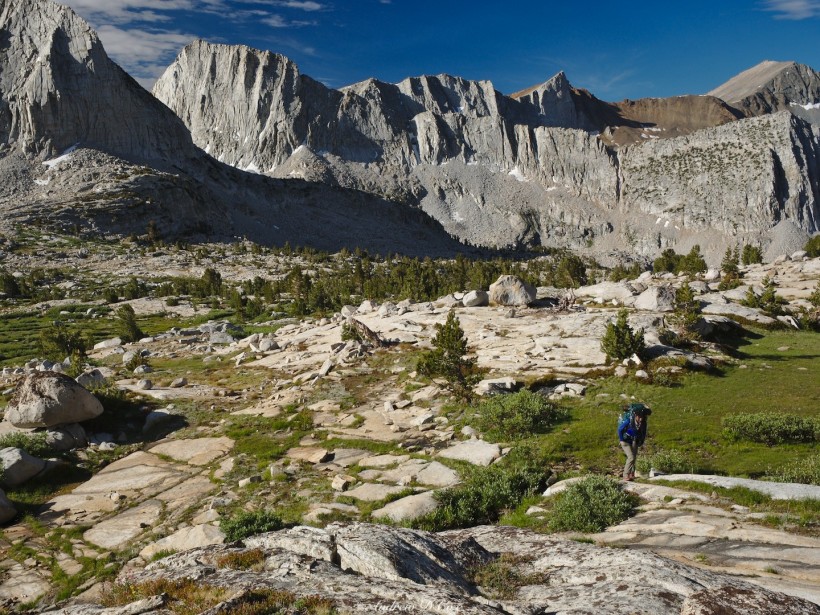
Eventually, Amanda and I leave the lush, green, mosquito-ridden meadows and climb into drier terrain. After a few iterations of compulsive map-checking, we agree on a saddle and begin a more rigorous ascent. Even after several days at altitude, I find the climbing difficult here at 11,000+ feet, although I do enjoy walking along the soft, grassy slope littered with granite boulders.
We soon reach the next High Route landmark, a “large lake encircled by talus,” confirming that we’ve correctly identified Frozen Lake Pass. We pause for a break and stare up at our route. From the far side of the lake, the ascent looks impossibly steep, completely covered in large boulders. A diagonal slot on the slope leads to the distinct notch that marks the pass, but beyond… who knows?
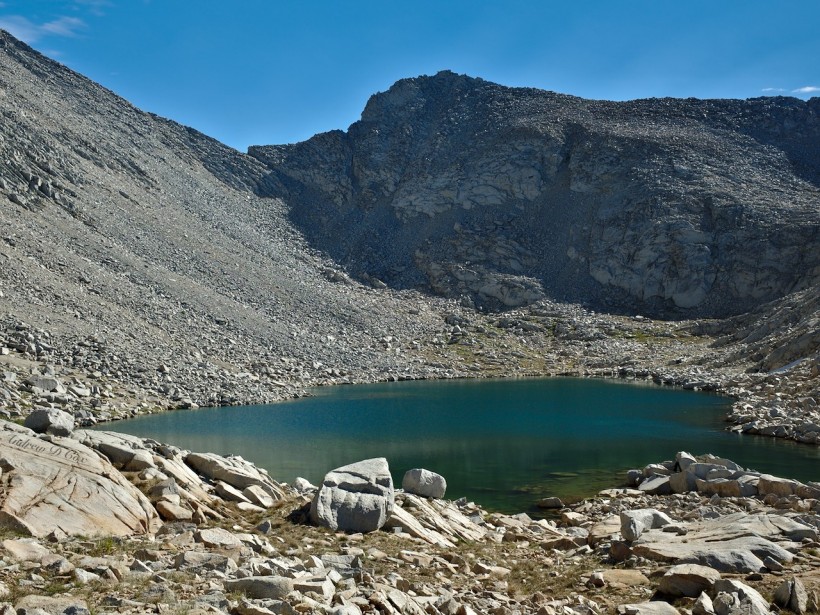
After a short break, we gather our wits and begin walking around the lake. Water sloshes between the rocks, gurgling as we hop between stones. We soon reach the opposite side of the lake; staring up at the pass, the slope seems slightly less steep. There’s only one thing to: begin the climb!

At first, we make quick work of the ascent. Plenty of sandy patches between boulders supply an easy route upward. Soon, however, we’re faced with a solid slope of talus. Roper warns that some of the stones may be unstable, so we push and prod the rocks before committing our weight to them. Amanda and I have slightly different styles when it comes to climbing a pile of boulders. I prefer to zig-zag across the slope, identifying strings of rocks that form little ramps and bring me slightly closer to the top. Amanda, on the other hand, keeps her eye on the prize and climbs more directly up the slope, employing bouldering moves to scramble up and over the talus. We both settle into our respective grooves and actually enjoy the climb!
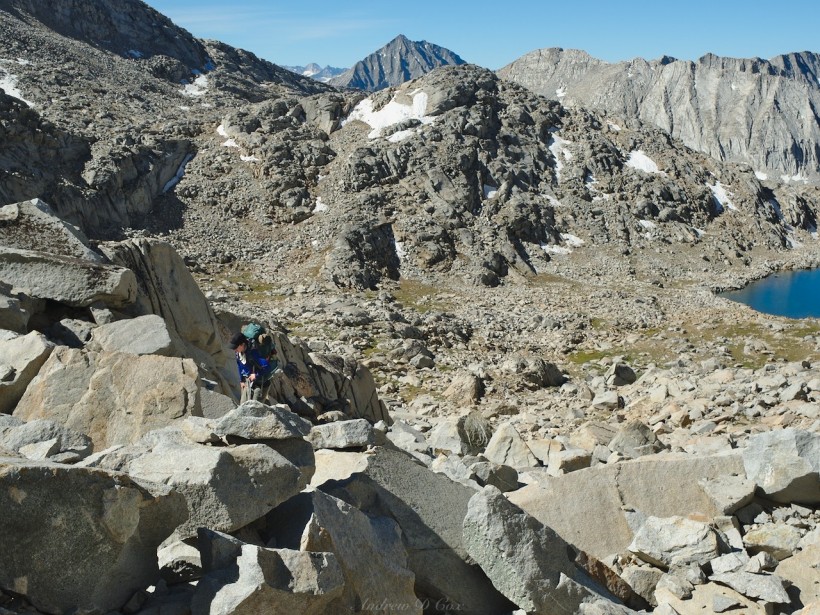
I’m surprised to find an abundant population of wildflowers between the rocks. There is little soil to be found and even less water, but bouquets of yellow flowers that look like dandelions dot the terrain, and – higher up – a whole bunch of sky pilots thrive. I look back periodically to check out the views and am impressed by our speed. The talus-encircled lake has shrunk to a small puddle below us and Lake Basin seems a world away.
After about an hour of solving rock-climbing puzzles, we reach the pass and take a nice, long break. At over 12,380 feet above sea level, this saddle marks our highest point on the trip and the air is noticeably thin. Roper mentions a register kept in a cairn astride the pass, and, though I search for several minutes, I can’t locate it. Perhaps it was washed away with a heavy snowstorm, or perhaps I just haven’t looked long enough. I’m a bit bummed that Amanda and I won’t be able to sign it and read entries from previous Sierra High Route travelers.
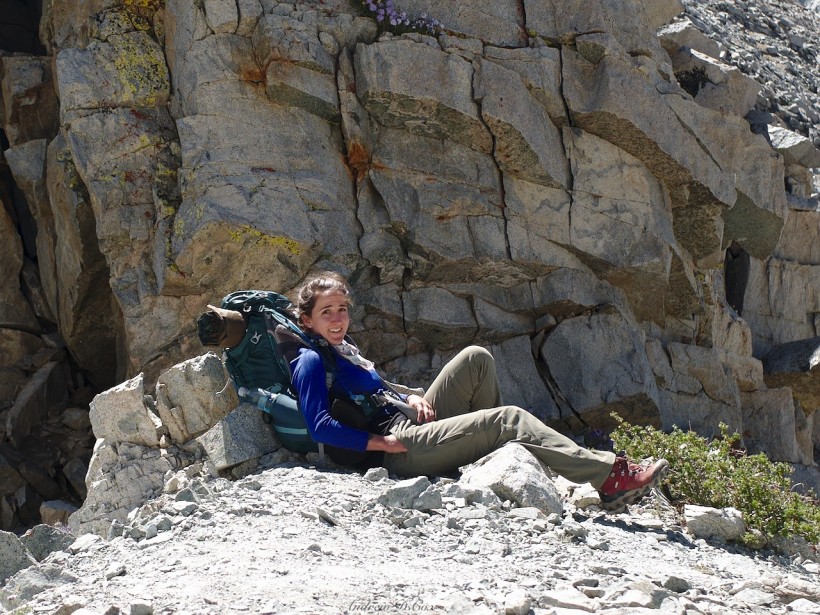
From the top of the pass, we gape at the vast array of peaks, lakes, and meadows to the south. I’m particularly enamored with Arrow Peak, a prominent mountain with sharp ridges. The landscape to the north is equally impressive, though Upper Basin contains notably fewer lakes than Lake Basin (which seems appropriate given their names). Somewhere far below is the Pacific Crest Trail / John Muir Trail, our next destination and the end of our adventure on the Sierra High Route, though certainly not the end of the trip!
We are considerably more wary of the descent from the pass than the ascent. I always prefer uphill travel – the downhill journey is nothing more than a controlled fall, and it’s easy to lose control, particularly when the footing is loose. And oh, is the footing on the north side of Frozen Lake Pass loose! We more or less slide down the first 50 feet of thin gravel before reaching familiar talus. To our right, a steep snowfield glitters in the sun. Protruding rocks and an excessive number of suncups make a glissade from this high point rather risky, so we descend a bit farther and then cut over to the soft snow. I’ll take walking on snow over talus-hopping any day. Thankfully, we’re able to descend all the way to a small tarn via the snow, avoiding hundreds of feet of precarious rocks.
Past the tarn, we’re faced with our final challenge on the SHR, a “disappointing dropoff.” It seems some rock-hopping is unavoidable on this descent. Amanda and I carefully pick our way down the slope to another tarn, and (finally) reach “solid” ground, i.e., rocks embedded in soil rather than heaped upon one another. We pick up speed and stride east across the alpine meadows toward the PCT/JMT; we can’t see it yet, but it must be there.
Originally, my plan for this trip was to hike from here to Pinchot Pass, then to Glenn Pass, and finally back to Road’s End via the Bubbs Creek Trail. However, we’ve taken longer than I anticipated (and, to be fair, the route was probably far too ambitious) and are four or five miles behind schedule. You, dear reader, already know the route we take but, at the time, we’re uncertain whether we’ll be able to take a shortcut down the Woods Creek Trail. Last year, the bridge spanning the South Fork of the Kings River washed out and has not yet been replaced, thus, travelers must wade across the river. With memories of last year’s high water still fresh in my mind, I’m unsure that the route is passable.
So, until we determine that we can take the Woods Creek shortcut, we proceed as if we have many miles to walk. Thankfully, hiking on the PCT is ridiculously easy compared to the Sierra High Route boulder-hopping, and we speed through the miles. In fact, Amanda runs down the trail (her preferred method of downhill travel) while I speedwalk, falling progressively farther behind her. Although I’ve traversed this canyon before, I’ve never actually set foot on this portion of the trail. Last year on the John Muir Trail, I had to skip this bit; several hikers died attempting to cross the Kings River and the trail was temporarily rerouted to cross the river where it is shallower in Upper Basin rather than further down the canyon.
In addition to the drastically easier walk, our travel along the JMT/PCT brings us into contact with far more people than we’ve seen in days. Besides the folks we chatted with while picking up our permit, we’ve seen a grand total of three humans since beginning our hike, and we met all of them during the first few miles on the Copper Creek Trail. In the first hour on the JMT, we speed past at least double or triple that number!
Thanks to our fast pace, we soon reach the Kings River and easily complete the river crossing. We query a few hikers lounging nearby to see if any of them have come up the Woods Creek Trail (is the route passable?), but none of them have ventured that far off the JMT. So we continue on past the river, beginning several miles of uphill hiking. We make quick work of the gradual switchbacks and emerge from the wooded slopes onto the gorgeous alpine meadows near Bench Lake. I run up to the nearby ranger station to inquire about our alternate route, but the station is empty; the ranger must be out elsewhere.
Still anxious about the potential for many miles ahead, we push on up the valley, passing a string of beautiful lakes that culminate in the breathtaking grandeur of Lake Marjorie. Although we’re both tired and could use a break, we pass the lake by. It would be nice to jump in and cool off but there are so many miles to go…
The ascent to Pinchot Pass stretches on and on. Each ridge fools us into thinking we’ve arrived at the summit, only to be disappointed when we see yet a higher hill ahead. I don’t remember it being this long, but then again, the last time I hiked this trail I was full of adrenaline, racing storm clouds to avoid yet another rainy day.
After much huffing and puffing, we reach the pass and collapse in exhaustion. I can’t recall the last time I was this tired, and we still have further to go; we can’t exactly camp here on the jagged, rocky terrain of Pinchot Pass. So, with much sighing, we shoulder our packs and descend from Pinchot Pass. For a while, I forget my tiredness and admire the stunning beauty of the landscape before me: the rich reds, greens, and blues, the sharp peaks, the meandering streams… absolutely stunning.
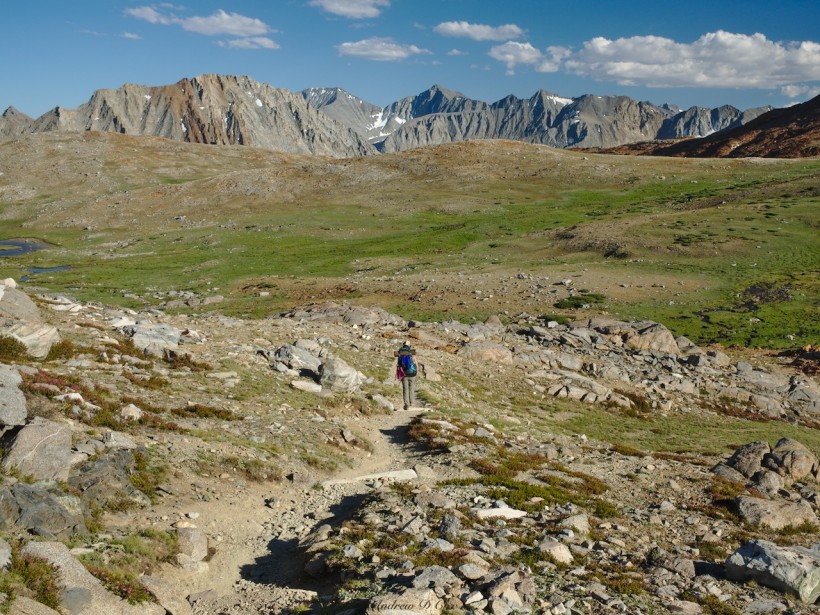
As we stroll through the rolling meadows, I find my eyes closing of their own accord, a new experience for me; how can I fall asleep while walking? Now hiking in determined, exhausted silence, Amanda and I press on for a few more miles to Wildlife Lake, a beautiful little pond surrounded by lush grass, shooting stars, and a set of perfect campsites nestled in the nearby pines. To my surprise, we’re the only backpackers here! I guess word hasn’t gotten out that this is one of the best campsites on the JMT.
Amanda sets up the tent while I cook dinner, a routine that has become familiar over the past few days. The mosquitoes arrive to extract our blood while we set up camp, but we’re just too tired to care and sit outside, defying the bugs to land and be smashed. Once the food has rehydrated, we eat, then brush our teeth and succumb to sleep at least.
All Downhill From Here
7 July 2018 | 18.9 mi | +900 / -6700 ft | View on Map
In the morning, Amanda and I wake up feeling refreshed and determined to make the most of the day. We quickly eat breakfast, pack up camp, and begin a long downhill trek along Woods Creek. It’s a clear day with lots of sunshine though our route remains shaded by the eastern mountains. Amanda quickly leaves me behind as she leaps and bounds down the trail.

As I hike down the trail at my own (respectable, mind you) pace, I reminisce about hiking this stretch of the John Muir Trail last year. The conditions are nearly identical: I left Wildlife Lake early in the morning and hiked through the shaded Woods Creek canyon. The lighting and colors are remarkably similar, but the massive snow bridges covering the creek are distinctly missing this year.
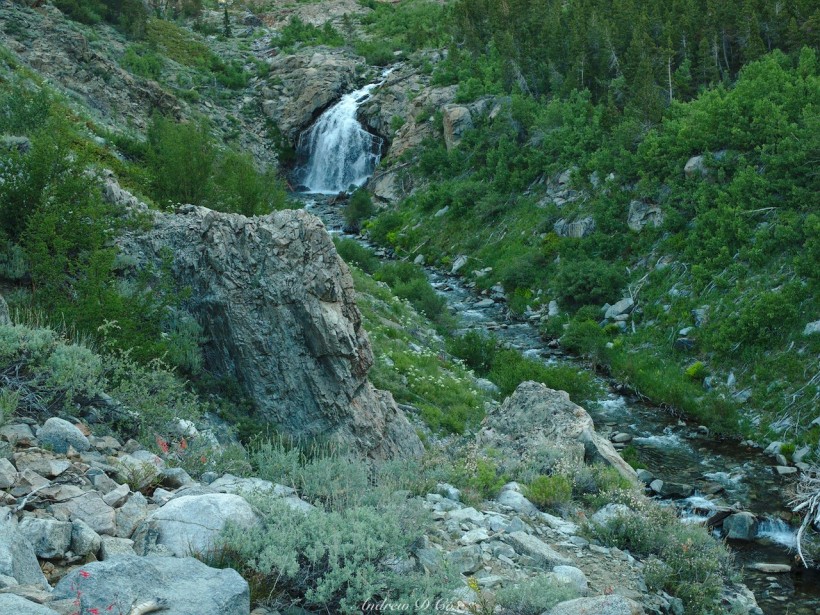
I reunite with Amanda at the Woods Creek bridge, where we find a small collection of thru-hikers drowsily emerging from their tents beside the trail. Amanda has already asked around and learned that the Woods Creek Trail is very much passable; we can easily manage the river crossing and cut a full 7 miles (and the ascent to Glenn Pass) out of our route! Finally able to relax, we spend some time at the bridge, eating snacks and admiring a twisted pine.
With our moods much improved, Amanda and I leave the suspension bridge behind and continue downhill along Woods Creek. The terrain soon begins to change as we lose altitude; we’re surrounded by drier grass, taller trees, and an abundance of chaparral. The impressive Castle Domes loom over us as we progress down the canyon through meadows full of wildflowers and several surprisingly hot, sandy plains.
We pause to admire the views of impressive granite cliffs further down the canyon, though not for long; the sun has already climbed high into the sky and is scorching hot; it’s best to pause in the shade.
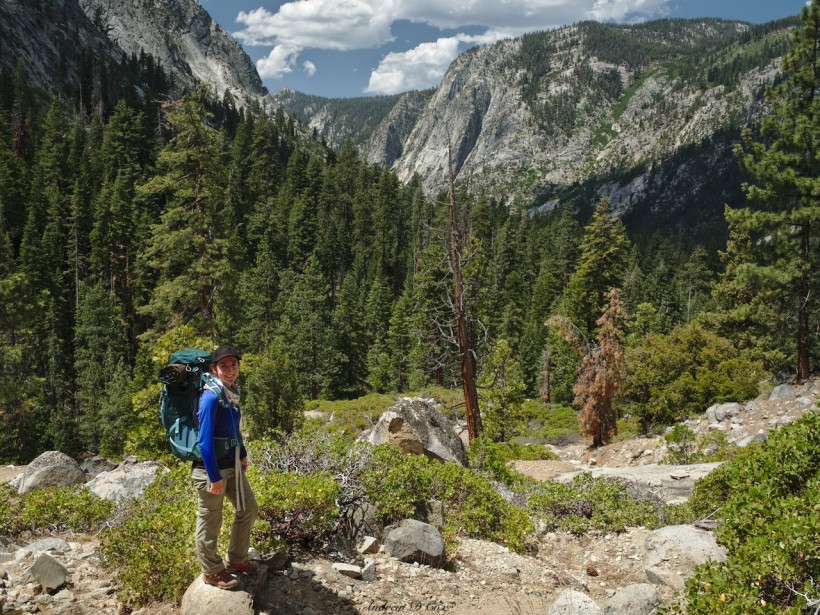
After several hot, dry miles, we reach a stream and take a long break to soak our feet in the ice-cold water and munch on snacks. Another pair of hikers arrive just as we’re leaving, and Amanda recognizes them from the permit line several days ago. They’re on their last leg of the Rae Lakes Loop and are headed out the same way as we are. Thoroughly refreshed from our long break, we give up our spots beside the water to them and continue down the trail.
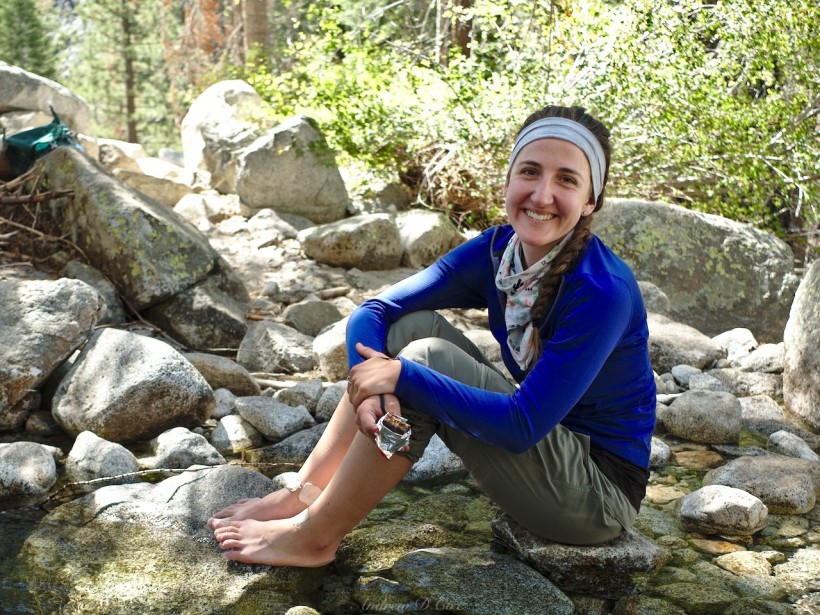
A short while later we reach the South Fork of the Kings River. The bridge is conspicuously missing, although two sets of stairs on either side of the river clearly mark its previous location. We deliberately wade through the wide, but shallow river to the other side, taking care to avoid slipping on the smooth rocks underfoot. My feet are soon numb from the frigid water, and for once I’m glad that it’s so hot outside; my shoes will dry in no time!
A set of established campsites on the far bank of the river marks our entry into a section of the canyon named “Paradise Valley.” It doesn’t seem very heavenly here, with oppressive heat radiating from the sandy soil between stands of pine trees. We hurry onward, hoping to find a cooler spot for lunch. We locate just such a location another mile down the trail and settle down for a much-needed multi-hour break next to the river. The water is slightly warmer here, so, after eating lunch, Amanda and I both wade in and cool down. We stay for a while, waiting out the afternoon heat on the shaded bank of the river.

Although our lunch spot by the water is perfectly wonderful, we have more miles to cover to reach the end of our loop and eventually continue walking. Somewhat paradoxically, the views down the canyon continue to improve as we descend. I’m really impressed by the glimmering granite walls; they’re comparable in grandeur to Yosemite Valley but without the crowds!
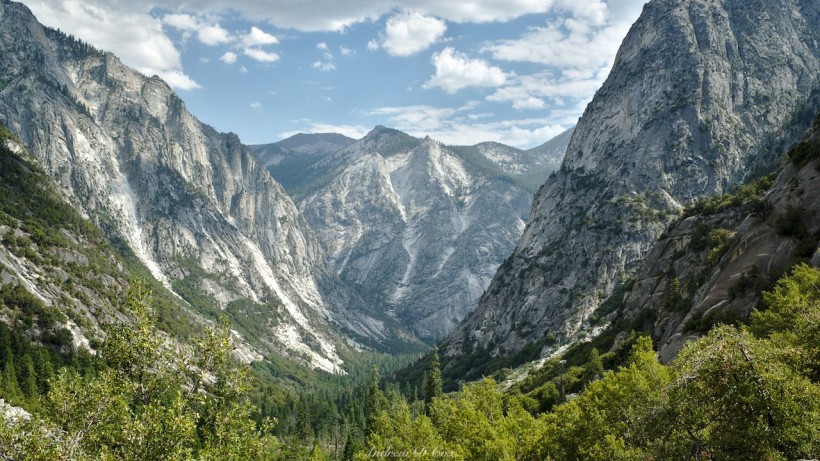
We’re soon descending an aggressive set of switchbacks that wind along exposed granite ridges. I enjoy the views but nearly step on a king snake, frightening both the snake and myself. At the bottom of the switchbacks, we arrive at Mist Falls, an aptly-named cascade that fills the air with cool water droplets. A dozen day hikers are scattered around the falls, taking selfies and generally enjoying themselves. The presence of this many shirtless dudes can mean only one thing: we must be close to the parking lot!
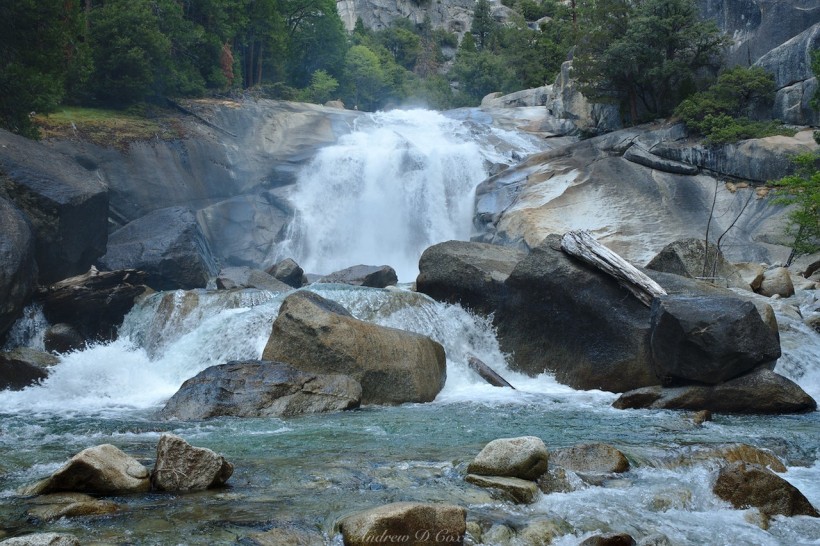
The final few miles of trail take us through a variety of very different biospheres. We trek along granite ramps beneath deciduous trees, then through a dark, foreboding forest of tall evergreens. Closer to the trailhead, we discover that a recent prescribed burn has left the entire landscape charred and covered in ash. The well-traveled miles of trail between the waterfall and the trailhead drift by and we soon find ourselves back in the familiar parking lot. I almost always find end of a hike a little bittersweet; exploring the backcountry is fun and exciting, but it sure is nice to return to flushing toilets and air conditioning. After changing into cleaner (and better smelling) clothes, we drive away, heading for hot food and the comforts of home.
Use the links below to read about other sections of the Sierra High Route
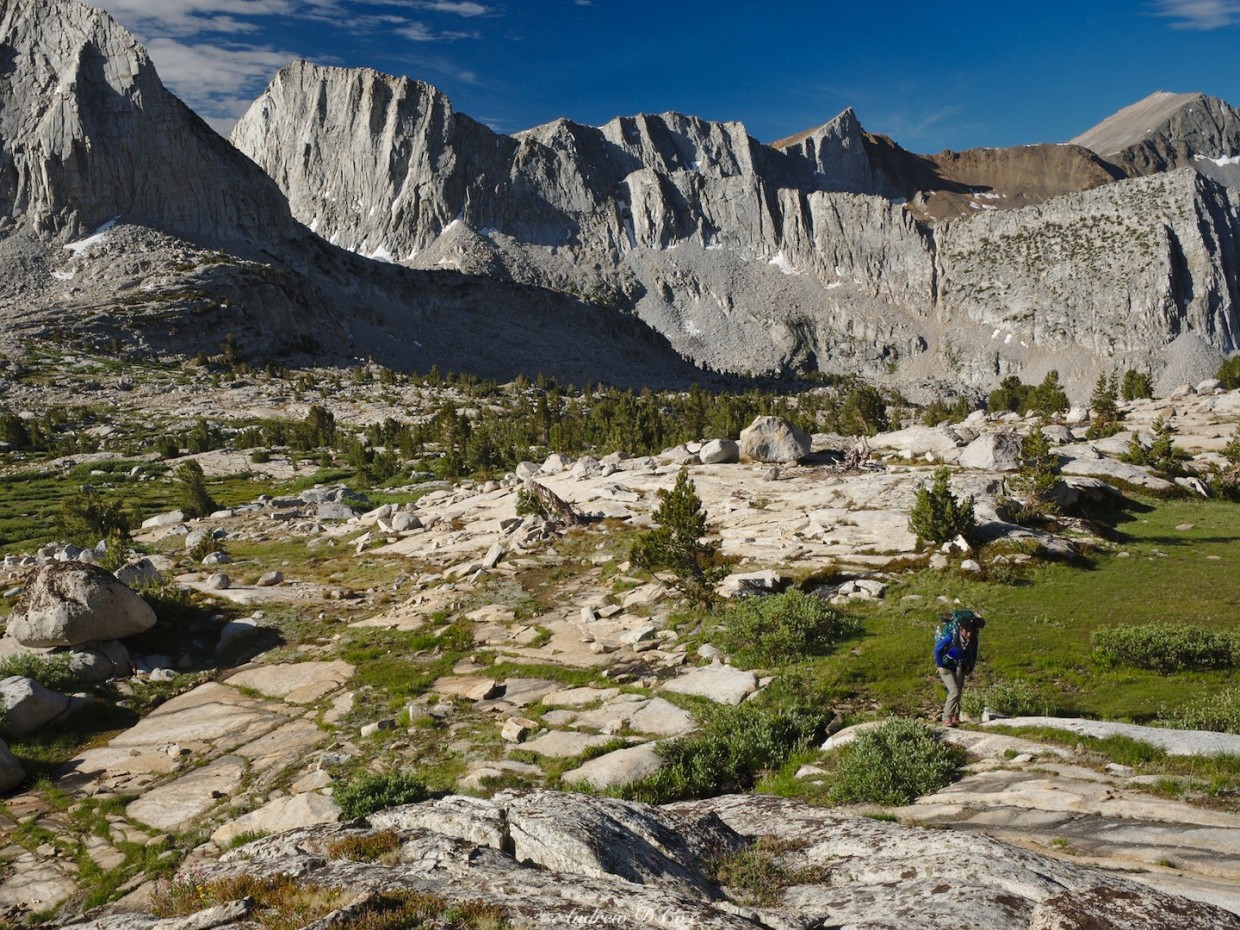



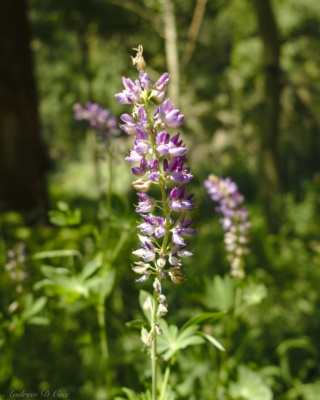





















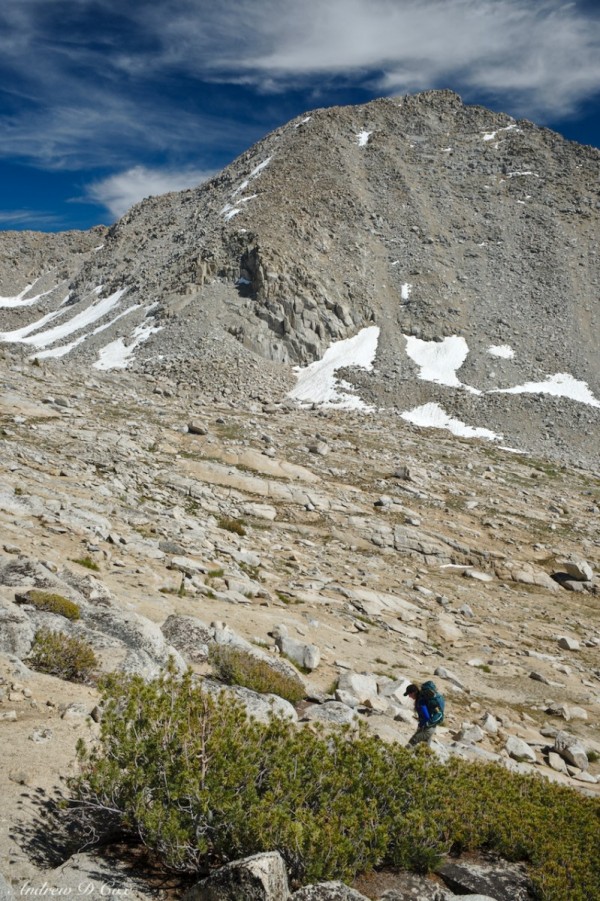

































Ironmanda 26 July 2018
Loved reading this!!! Brings back the happy funny memories of the trip.. even though it was only a few weeks ago. Can’t wait for the next adventure 🙂
Kevin 11 February 2022
Thanks for the write-up, this is the exact route I’m going this July.
Thanks
George 3 January 2023
Great write-up and wonderful pictures! Your pictures inspired me to deviate from the northern SEKI loop I had planned with my son and we ended up taking this route, except we took Cartridge Pass out of the Lakes Basin and stayed on the JMT until we exited out Bubbs Creek. I didn’t have Roper’s book (although I’ve since acquired it) and enjoyed navigating more or less point to point. I think it was helpful not to have on White Pass as we just dropped down a little ways off the left side of White Pass and it was pretty easy hiking over to Red Pass, it looked much more difficult to me to stay high as Roper recommends. Again, many thanks for the well done report!